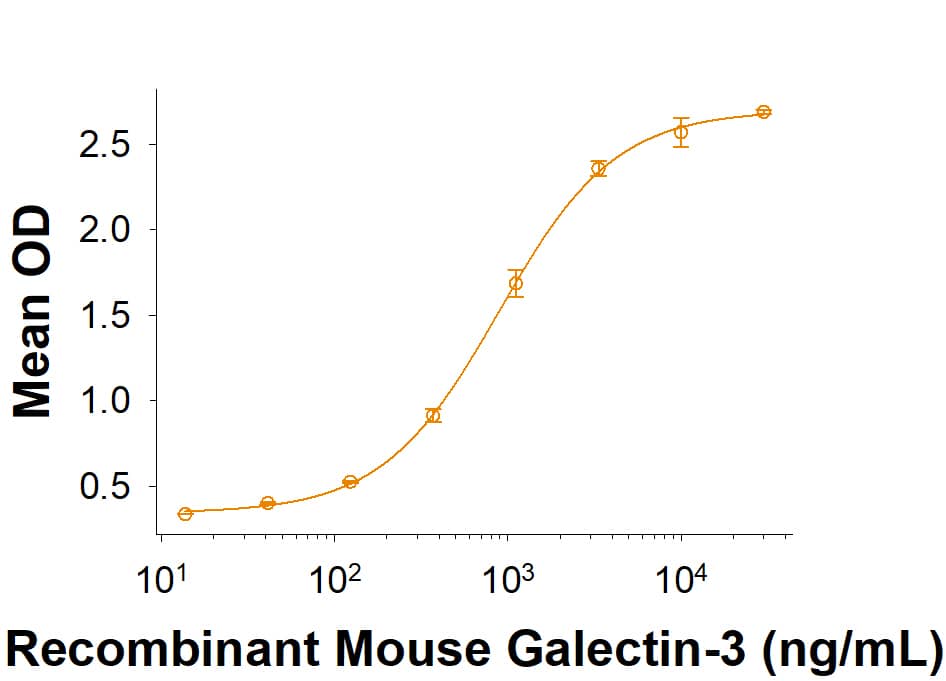Recombinant Mouse Siglec-E Fc Chimera Protein, CF
R&D Systems, part of Bio-Techne | Catalog # 5806-SL

Key Product Details
Source
NS0
Accession #
Structure / Form
Disulfide-linked homodimer
Conjugate
Unconjugated
Applications
Bioactivity
Product Specifications
Source
Mouse myeloma cell line, NS0-derived mouse Siglec-E protein
| Mouse Siglec-E (Met1-Phe355) Accession # AAH23280 |
IEGRMDP | Mouse IgG2A (Glu98-Lys330) |
| N-terminus | C-terminus |
Purity
>95%, by SDS-PAGE under reducing conditions and visualized by silver stain.
Endotoxin Level
<0.10 EU per 1 μg of the protein by the LAL method.
N-terminal Sequence Analysis
No results obtained, N-sequencing might be blocked: Gln20 predicted
Predicted Molecular Mass
64.6 kDa (monomer)
SDS-PAGE
75-95 kDa, reducing conditions
Activity
Measured by its binding ability in a functional ELISA.
When Recombinant Mouse Siglec‑E Fc Chimera is immobilized at 2 μg/mL (100 μL/well), it binds to Recombinant Mouse Galectin-3 (HEK293-expressed) Protein (Catalog # 9039-GAB) with an ED50 of 0.08-0.8 μg/mL.
When Recombinant Mouse Siglec‑E Fc Chimera is immobilized at 2 μg/mL (100 μL/well), it binds to Recombinant Mouse Galectin-3 (HEK293-expressed) Protein (Catalog # 9039-GAB) with an ED50 of 0.08-0.8 μg/mL.
Scientific Data Images for Recombinant Mouse Siglec-E Fc Chimera Protein, CF
Recombinant Mouse Siglec-E Fc Chimera Protein Binding Activity
When Recombinant Mouse Siglec-E Fc Chimera (Catalog # 5806-SL) is immobilized at 2 µg/mL (100 µL/well), Recombinant Mouse Galectin-3 (HEK293-expressed) Protein (Catalog # 9039-GAB) binds with an ED50 of 80-800 ng/mL.Formulation, Preparation and Storage
5806-SL
| Formulation | Lyophilized from a 0.2 μm filtered solution in PBS. |
| Reconstitution |
Reconstitute at 100 μg/mL in PBS.
|
| Shipping | The product is shipped at ambient temperature. Upon receipt, store it immediately at the temperature recommended below. |
| Stability & Storage | Use a manual defrost freezer and avoid repeated freeze-thaw cycles.
|
Background: Siglec-E
References
- Varki, A. and T. Angata (2006) Glycobiology 16:1R.
- Crocker, P.R. et al. (2007) Nat. Rev. Immunol. 7:255.
- Yu, Z. et al. (2001) Biochem. J. 353:483.
- Ulyanova, T. et al. (2001) J. Biol. Chem. 276:14451.
- Zhang, J.Q. et al. (2004) Eur. J. Immunol. 34:1175.
- Boyd, C.R. et al. (2009) J. Immunol. 183:7703.
- Erdmann, H. et al. (2009) Cell. Microbiol. 11:1600.
Long Name
Sialic Acid Binding Ig-like Lectin E
Alternate Names
SiglecE
Entrez Gene IDs
83382 (Mouse)
Gene Symbol
SIGLECE
UniProt
Additional Siglec-E Products
Product Documents for Recombinant Mouse Siglec-E Fc Chimera Protein, CF
Product Specific Notices for Recombinant Mouse Siglec-E Fc Chimera Protein, CF
For research use only
